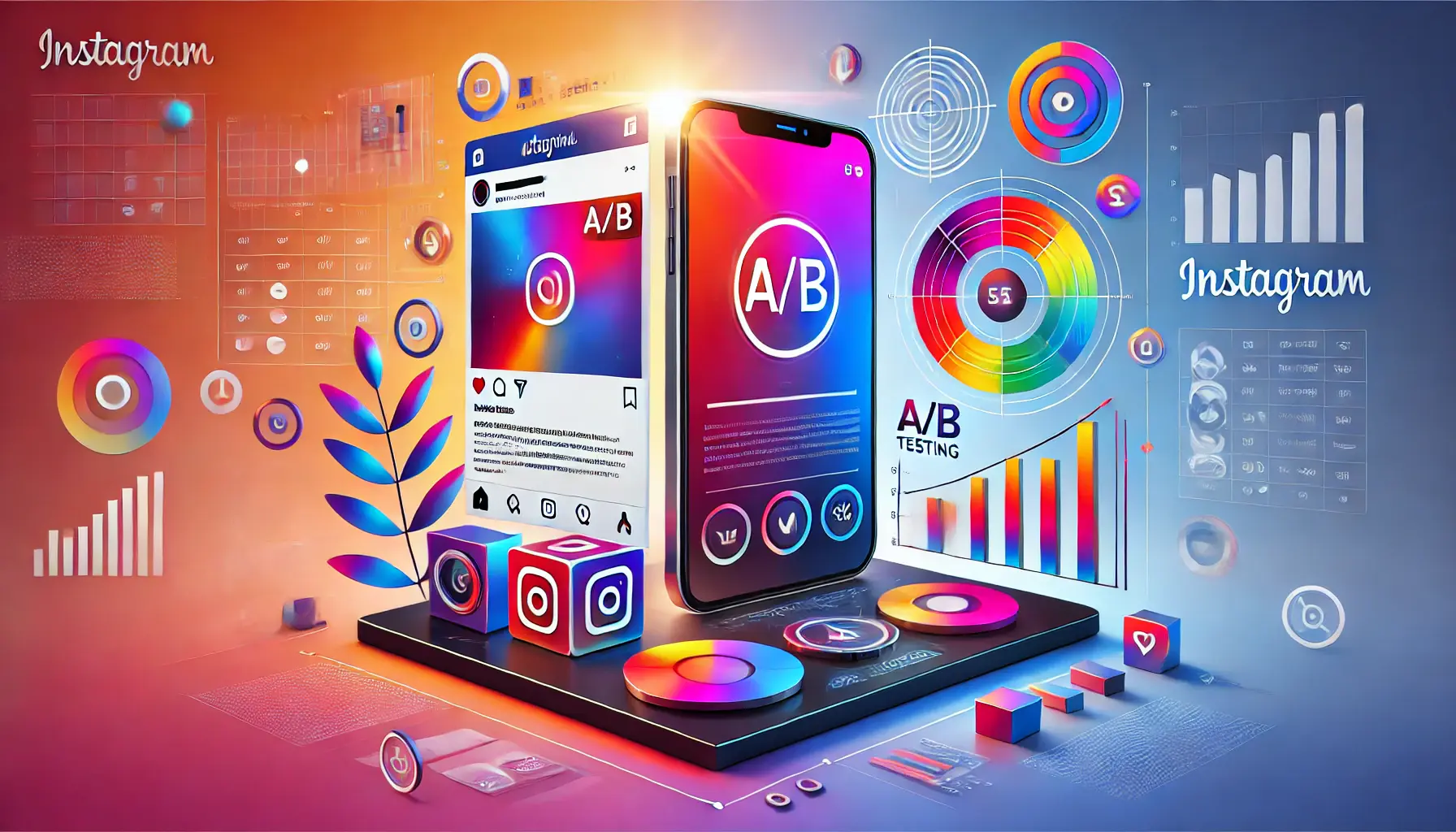In today’s digital age, Instagram is a force to be reckoned with when it comes to reaching a massive and engaged audience for businesses.
However, simply launching ads on the platform is not enough.
To truly harness its power, understanding and implementing ad testing is necessary.
Ad testing, also known as A/B testingA method of comparing two versions of an ad to determine which performs better., involves experimenting with various elements of your ads to determine what works best with your audience.
This is an essential process for maximizing campaign performance, optimizing engagement, and generating the highest possible return on investment (ROIReturn on Investment, a measure of the profitability of an advertising campaign.).
- Understanding Ad Testing in Instagram Campaigns
- Key Components to Test in Instagram Ads
- Effective Ad Testing Strategies for Instagram
- Best Practices for Running Ad Tests on Instagram
- Analyzing and Applying Ad Test Results
- The Power of Ad Testing in Instagram Campaigns
- Frequently Asked Questions About Ad Testing in Instagram Campaigns
Understanding Ad Testing in Instagram Campaigns
Preparing for ad testing can be a productive and insightful experience.
Let’s explore its fundamental concepts.
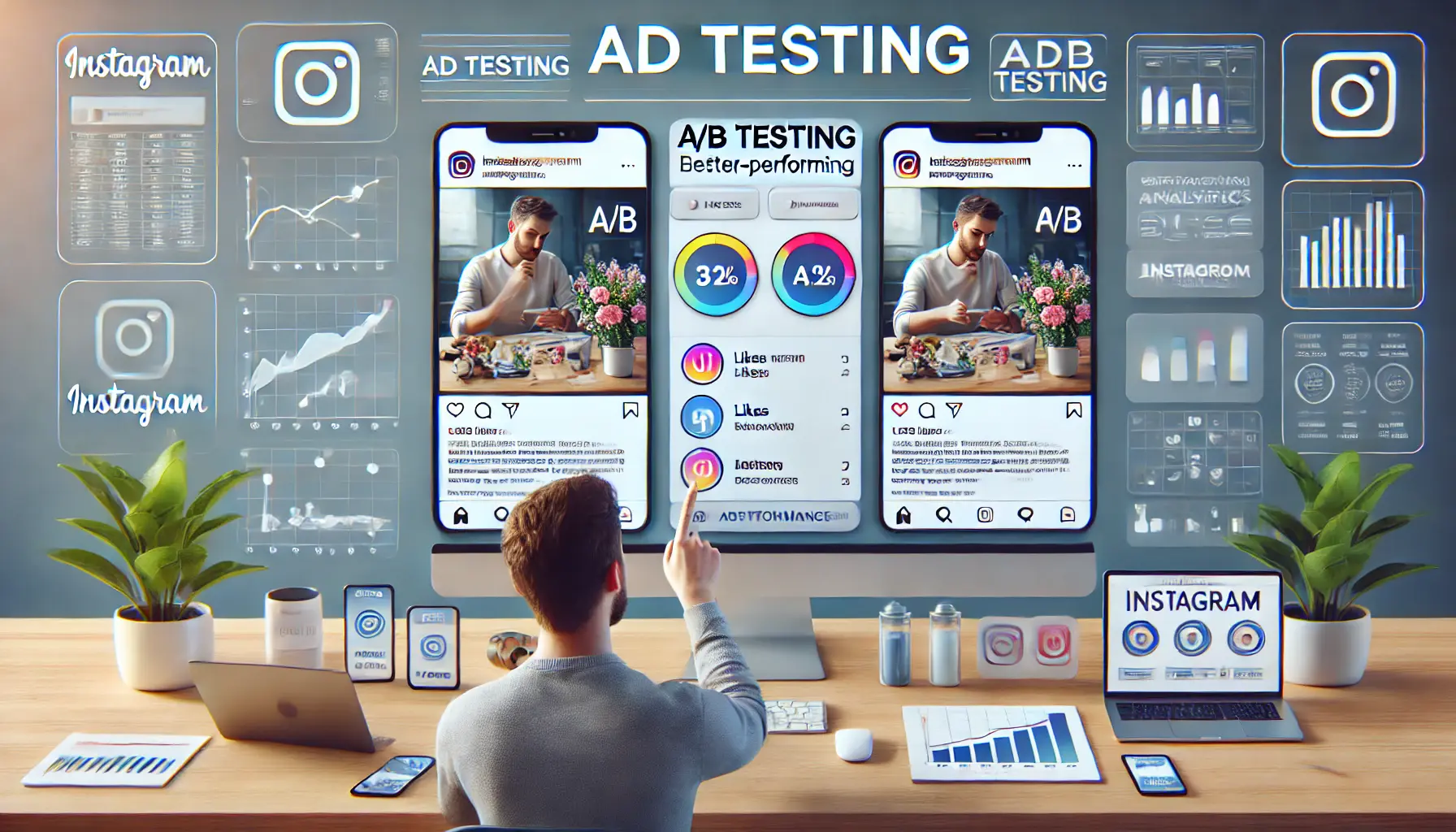
Visual representation of A/B testing in digital marketing, showcasing ad variations and engagement metrics.
Definition and Purpose of Ad Testing
At its core, ad testing is the systematic practice of comparing multiple versions of an ad to determine which one performs better.
By conducting these tests, advertisers can make data-driven decisions instead of relying on guesswork, allowing them to implement strategies backed by empirical evidence.
Think about it—have you ever wondered why one ad gets significantly more engagement than another?
The answer often lies in subtle differences that ad testing helps identify.

Illustration of a marketing team leveraging ad testing insights to improve campaign effectiveness.
Benefits of Implementing Ad Testing
Including ad testing in your Instagram campaigns offers a wealth of advantages:
- Increased Engagement: By understanding what resonates with your audience, you can craft content that grabs attention and encourages interaction.
- Optimized Budget Allocation: Investing in high-performing ads ensures that your marketing dollars are spent efficiently, minimizing wastage.
- Improved Conversion Rates: Refining ad elements can lead to higher conversion rates, turning viewers into loyal customers.
Through my own experiences, I have found that campaigns incorporating ad testing consistently outperform those that do not.
It’s like having a compass that directs your marketing efforts in the right direction.
As we move forward, we’ll dive into the specific elements within Instagram ads that should be tested to ensure your campaigns are both effective and compelling.
Ad testing helps you make data-driven decisions instead of relying on assumptions. It allows advertisers to refine strategies based on real user interactions.
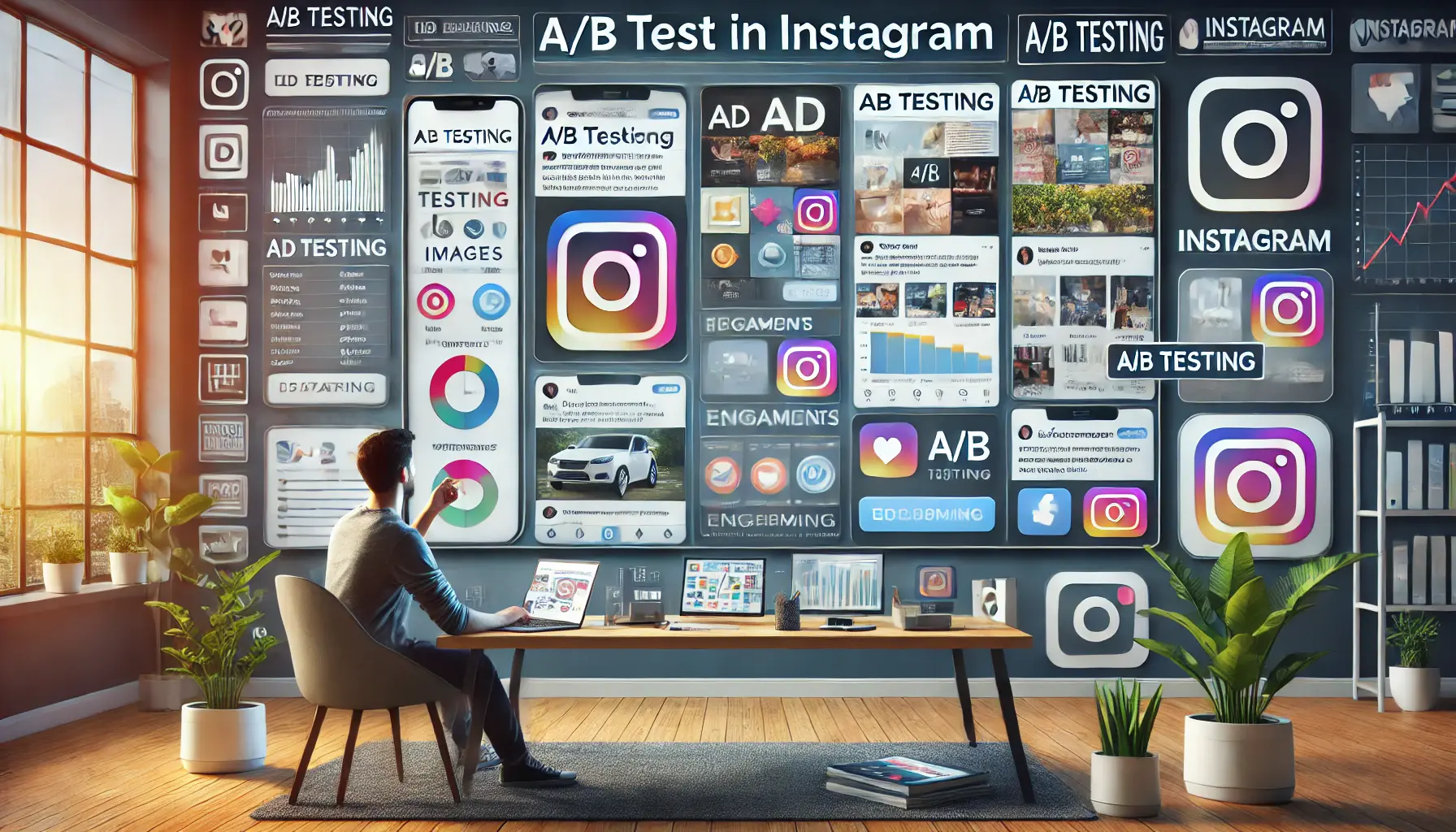
Illustration of ad testing in Instagram campaigns, focusing on different ad elements for performance optimization.
Key Components to Test in Instagram Ads
Diving into ad testing in your Instagram marketing must be methodical.
By testing particular components, you will discover what performs best for your audience, leading to improved engagement and conversions.
Let’s explore the critical components to test:

Illustration of ad testing for visual content, comparing images and video ads for Instagram campaigns.
Visual Content: Images and Videos
Instagram’s image-focused platform makes the quality and attractiveness of your photos and videos extremely important.
Experimenting with visual aspects can dramatically influence the success of your ad testing strategy:
- High-Quality Imagery: Sharp, well-lit, professional photography will present your product or service in a positive manner and help draw users in. High-quality visuals grab attention and enhance credibility.
- Video Content: Test short, engaging videos that highlight your products. Videos often achieve higher engagement rates than still images, making them an excellent way to improve ad performance.
- Content Variations: Experiment with different themes, colors, and styles to see what resonates best with your audience. Including photos of people using your product can personalize your brand and create a stronger emotional connection.
Keep in mind that the goal is to make your visuals not only attention-grabbing but also complementary to your brand’s message and identity.

Illustration of ad copy and headline testing for Instagram campaigns, focusing on performance optimization.
Ad Copy and Headlines
The textual component of your ad plays a crucial role in delivering your message and driving action.
Consider testing the following elements as part of your ad testing process:
- Headlines: Write compelling headlines that immediately convey your value proposition. Experiment with different wordings and lengths to determine what captures attention most effectively.
- Primary Text: Test various copy styles—such as storytelling, direct offers, or question-based approaches—to see which one connects best with your audience.
- Tone and Voice: Align the tone of your ad copy with your brand personality. Whether informal, formal, humorous, or inspirational, a consistent voice reinforces brand recognition.
Effective ad copy should be concise, clear, and tailored to address the needs and desires of your audience.

Illustration of CTA button testing for Instagram campaigns, emphasizing different designs and placements for optimization.
Call-to-Action (CTA) Buttons
Your CTA serves as the bridge between capturing attention and prompting action.
Testing different CTAs can reveal what compels your audience to engage:
- CTA Phrases: Use action-driven phrases like “Shop Now,” “Learn More,” or “Sign Up” to drive immediate responses. Test different variations to find the most effective wording.
- Button Placement: Although Instagram ads have standardized CTA button placements, ensure your ad’s design naturally guides the viewer’s eye toward the CTA.
An effective CTA creates a sense of urgency and makes it clear what action you want your audience to take next.

Illustration of Instagram ad formats and placements, comparing various ad types and their performance across different sections of the platform.
Ad Formats and Placements
Instagram offers multiple ad formats and placements, each with unique opportunities to engage users.
Testing these variations can help uncover the most effective combinations for your ad testing strategy:
- Ad Formats: Experiment with different formats such as photo ads, video ads, carousel ads, and Stories ads. Each format provides varied ways to present content and engage audiences.
- Placements: Test ad placements across Instagram’s Feed, Stories, Explore page, and Reels. Evaluating performance across different placements can guide better budget allocation.
By alternating between ad formats and placements, you can reach different segments of your audience and identify where your ads perform best.
Incorporating these ad testing strategies into your Instagram campaigns allows you to make data-driven decisions, optimize performance, and achieve stronger results.
Remember, continuous experimentation and analysis are essential to staying ahead in the ever-evolving world of social media advertising.
Testing individual elements of your Instagram ads—such as visuals, ad copy, and CTAs—helps identify what drives the best engagement and conversion rates.

Illustration of ad testing strategies for Instagram campaigns, emphasizing A/B testing, multivariate testing, and sequential testing.
Effective Ad Testing Strategies for Instagram
Effective ad testing strategies are essential for optimizing your Instagram ads.
By scientifically experimenting with various elements of an ad, you can identify what performs best with your audience, leading to higher engagement and conversions.
Below are some effective strategies to enhance your campaigns.

Illustration of A/B testing methodology for Instagram ads, comparing ad variations with performance metrics.
A/B Testing Methodology
A/B testing, or split testing, is the process of comparing two versions of an ad to determine which one is more effective.
This allows you to test a single variable—such as the image, headline, or call-to-action—while keeping everything else constant.
Based on the results, you can make informed decisions to maximize your ad performance.
For instance, testing different headlines can reveal which one attracts more attention and leads to higher engagement.
This method is simple yet highly effective for refining your Instagram ad testing approach.
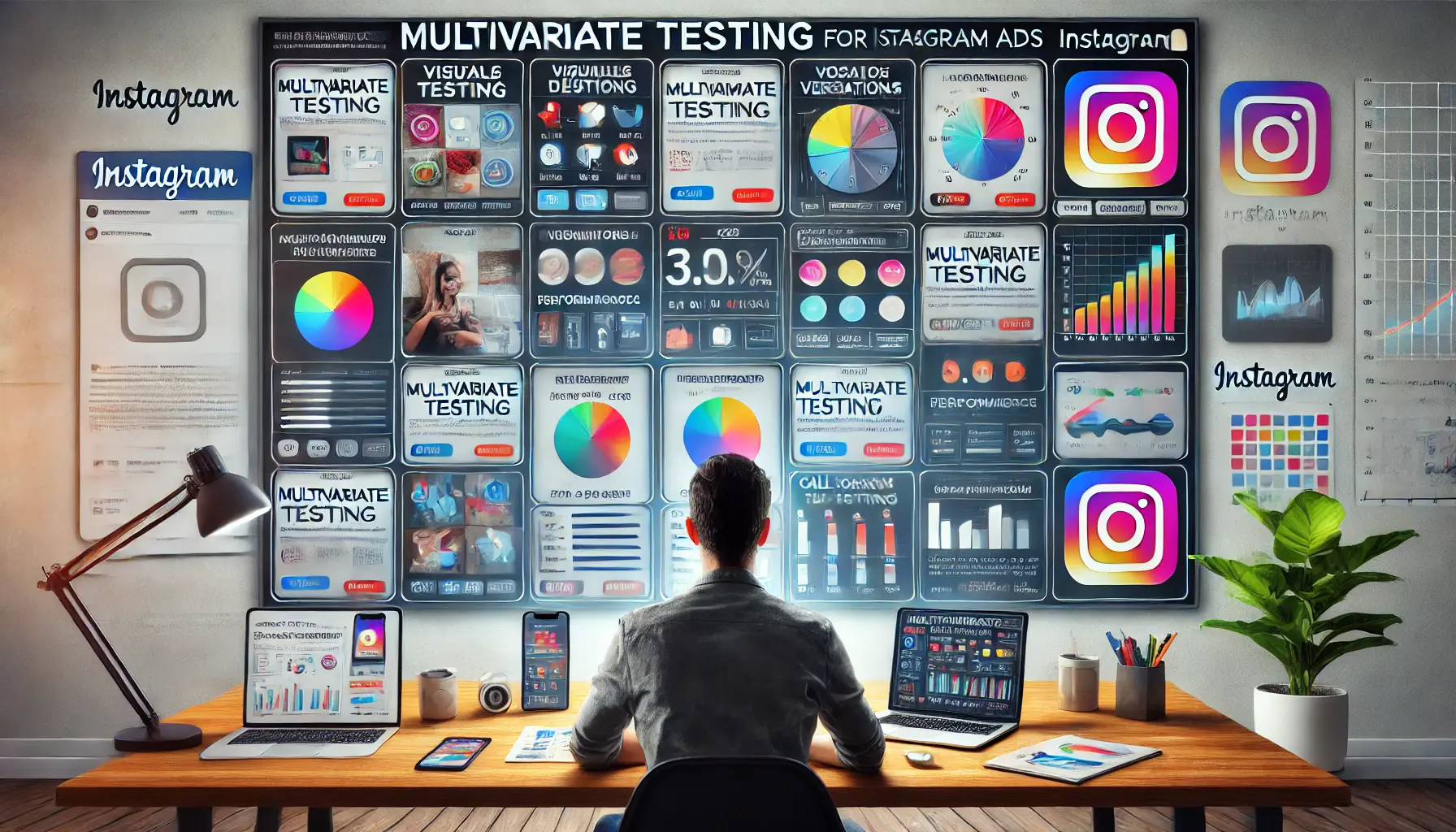
Illustration of multivariate testing for Instagram ads, comparing multiple ad variations with different elements to optimize performance.
Multivariate Testing
Multivariate testing takes A/B testing a step further by analyzing multiple variables within an advertisement simultaneously.
This strategy helps you understand how different elements interact and which combinations yield the best results.
Although more complex, multivariate testingA testing method that evaluates multiple variables simultaneously to determine the best-performing combination. provides deeper insights into user behavior and preferences.
By testing various headlines, images, and CTAs together, you can optimize your ad creatives with greater precision.

Illustration of sequential testing for Instagram ads, showcasing the process of gradual optimization over time with performance metrics.
Sequential Testing
Sequential testing involves making gradual changes to your ads over time and observing their impact on performance metrics.
This approach is particularly useful for assessing the long-term effects of specific ad components and how audience responses evolve.
By analyzing trends and patterns, you can fine-tune your advertising strategy to ensure it remains relevant and effective in the ever-changing Instagram landscape.

Illustration of utilizing Instagram’s Trial Reels feature to test new content and analyze engagement metrics.
Utilizing Instagram’s Trial Reels Feature
In December 2024, Instagram introduced a feature that allows creators to test experimental Reels among non-followers before sharing them with their regular audience.
This feature provides engagement data—such as views, likes, shares, and comments—within 24 hours of posting.
Leveraging this tool can help you experiment with new content ideas without jeopardizing engagement rates or follower satisfaction.
By testing Reels with a broader audience first, you can gauge their performance before making them widely available.
By incorporating these ad testing strategies into your Instagram campaigns, you can refine your advertising efforts, gain deeper insights into your audience, and drive more successful outcomes.
A/B testing is one of the most reliable ways to determine what works best in your Instagram ads. Always test one element at a time for accurate results.

Illustration of best practices in running Instagram ad tests, comparing various ad variations for optimal performance.
Best Practices for Running Ad Tests on Instagram
Applying successful ad testing on Instagram is crucial to optimizing your campaigns and achieving improved results.
Following best practices ensures that your tests are accurate and yield actionable insights.
Below are some important guidelines to follow:

Illustration of testing one variable at a time in Instagram ad campaigns, highlighting the comparison of single-variable changes.
Test One Variable at a Time
To accurately determine which element impacts your ad’s performance, it’s essential to isolate variables.
By testing only one variable at a time—such as the image, headline, or call-to-action—you can pinpoint what drives better engagement or conversions.
This approach prevents confounding results and provides clear direction for optimization.
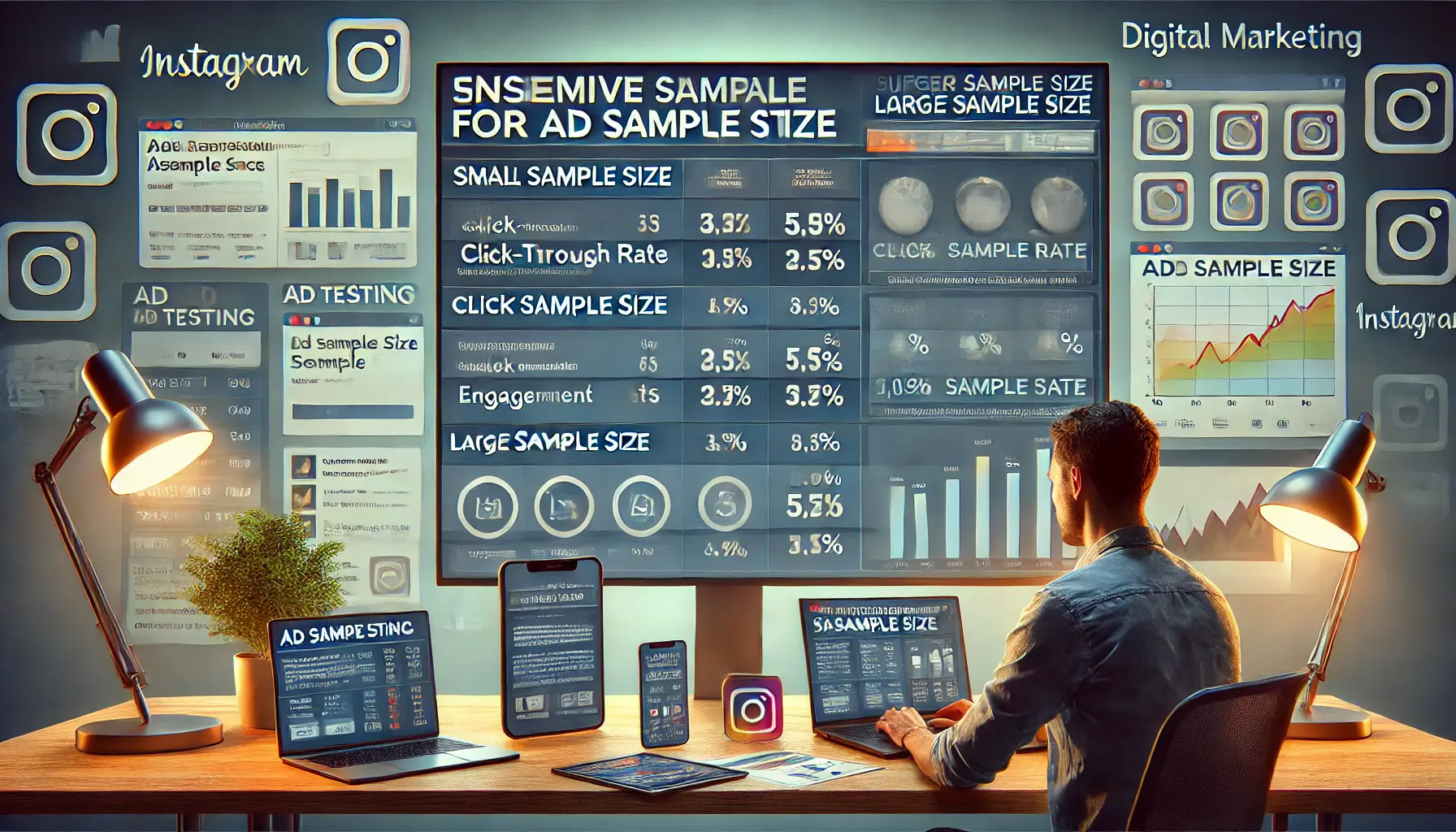
Illustration of the importance of ensuring significant sample sizes in Instagram ad testing for accurate performance metrics.
Ensure Significant Sample Sizes
The reliability of a test largely depends on the sample sizeThe number of individuals included in a study or test to ensure statistical significance..
Conducting ad testing with too small an audience can result in inaccurate conclusions.
Opt for a sample size that is statistically significant so your results are both reliable and actionable.
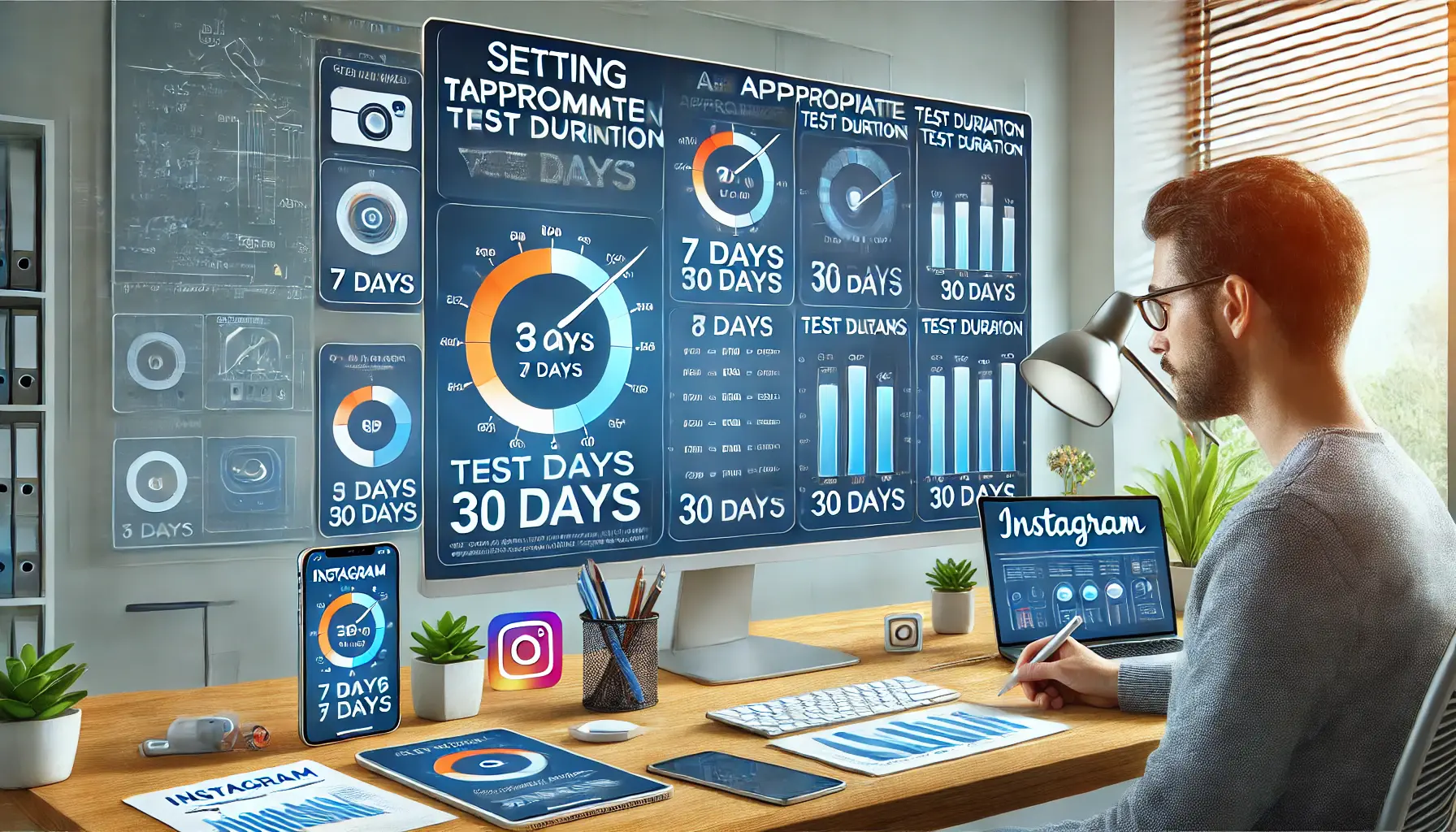
Illustration of setting appropriate test durations for Instagram ad testing, comparing the performance of different test lengths.
Set Appropriate Test Durations
The duration of your ad testing is essential for data validity.
Running tests for too short a period may overlook daily variations in user activity.
Experts recommend a minimum test duration of seven days to collect a robust data set, with an upper limit of 30 days to maintain relevance.

Illustration of controlling external factors during Instagram ad testing to ensure accurate performance data.
Control External Factors
External events, such as holidays, major cultural moments, or economic fluctuations, can influence user behavior and ad performance.
Scheduling your ad testing during periods without significant external disruptions helps ensure that the data reflects the actual impact of the variables you are examining, rather than external influences.

Illustration of using Instagram’s native tools for ad testing, including Ads Manager and performance analytics.
Make Use of Instagram’s Native Tools
Instagram offers built-in features that simplify ad testing.
Leveraging these tools can enhance the accuracy and efficiency of your tests:
- A/B Testing Features: Instagram’s Ads Manager provides built-in A/B testing features, allowing you to compare different ad versions seamlessly.
- Insights and Analytics: Utilize Instagram’s analytics to monitor performance metrics, providing valuable data to inform future ad strategies.
By implementing these best practices, you can conduct ad testing on Instagram effectively, gaining insights that will help you optimize your strategies and achieve the best campaign performance.
Make sure your tests run long enough to collect statistically significant data. Short testing periods can lead to misleading results.

Illustration of analyzing and applying ad test results to optimize Instagram campaigns based on performance metrics.
Analyzing and Applying Ad Test Results
After running a successful ad testing campaign on Instagram, the next crucial step is analyzing the results and applying key insights to optimize future ads.
Without a proper evaluation process, the effort put into testing could be wasted.
Here’s how to effectively interpret and apply your ad testing results:

Illustration of interpreting key performance metrics for Instagram ads, including visual graphs for engagement and conversion data.
Interpreting Key Performance Metrics
To measure the success of your ad testing, focus on these key performance metrics:
- Click-Through Rate (CTR): Quantifies how many users clicked on your ad after viewing it. A higher CTR reflects compelling ad copy and imagery.
- Conversion Rate: Measures how many users took a desired action—such as making a purchase, signing up, or downloading—after interacting with your ad.
- Cost Per Click (CPC): Monitors how much you are paying for each ad click. Lower CPC values indicate better cost efficiency.
- Engagement Rate: Analyzes likes, shares, and comments to determine how well your ad resonates with your audience.
- Return on Ad Spend (ROAS): Evaluates the revenue generated per dollar spent on an ad. A higher ROAS signifies a more profitable campaign.

Illustration of making data-driven decisions for Instagram ad optimization based on performance metrics and actionable insights.
Making Data-Driven Decisions
Once you’ve gathered insights from your ad testing data, leverage it to make informed decisions:
- Optimize Poor-Performing Ads: Identify underperforming ads and modify their visuals, headlines, or CTAs based on top-performing variations.
- Scale High-Performing Ads: Increase your budget for ads with high engagement and conversion rates to maximize their impact.
- Refine Targeting Parameters: Use demographic insights to adjust targeting settings and ensure your ads reach the most relevant audience.

Illustration of ongoing optimization in Instagram ad campaigns, focusing on the continuous improvement of ad performance.
Ongoing Optimization of Ad Campaigns
Ad testing is not a one-time process—it requires continuous monitoring and adjustments to maintain peak performance.
Keep these strategies in mind:
- Test Different Ad Formats: Experiment with various Instagram ad formats such as Stories, Reels, or Carousel Ads to engage different audience segments.
- Stay Updated on Industry Trends: Keep track of the latest social media marketing trends and algorithm changes to ensure your ads remain competitive and effective.
- Regularly Reassess Performance: Evaluate ad performance every few weeks and make necessary adjustments to improve results.
By thoroughly analyzing your ad testing data and applying the insights gained, you can continuously refine your Instagram ad campaigns, achieve higher ROI, and foster long-term business growth.
Always analyze key metrics such as CTRClick-Through Rate, the percentage of users who click on an ad after viewing it., CPCCost Per Click, the amount paid for each click on an advertisement., and ROASReturn on Ad Spend, a metric that measures revenue generated per dollar spent on advertising. to determine which ads are delivering the best ROI.
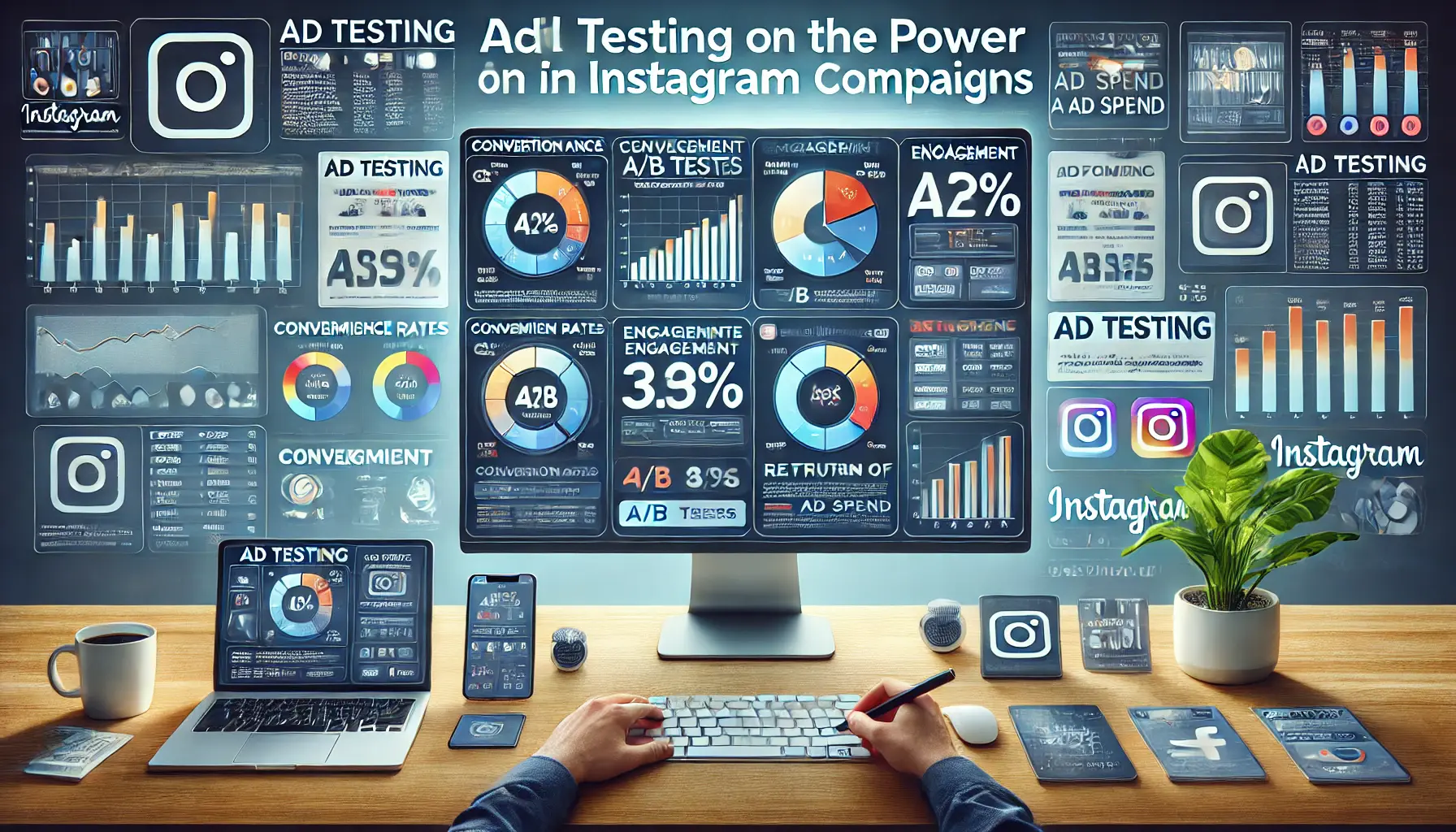
Illustration of the power of ad testing in Instagram campaigns, highlighting the effectiveness of A/B testing and optimization efforts.
The Power of Ad Testing in Instagram Campaigns
Ad testing is a central part of Instagram campaign optimization and is crucial for maximizing the effectiveness of your advertising efforts.
By continually optimizing different aspects of your ads, you can significantly enhance engagement, reduce costs, and improve return on investment (ROI).
Ad testing isn’t simply about running tests—it’s about leveraging data to create compelling and persuasive ads that truly engage your audience.

Illustration of the importance of ad testing in Instagram campaigns, highlighting the impact of testing on campaign success.
Why Ad Testing is Important
Instagram is one of the most competitive advertising platforms, and without proper ad testing, businesses risk wasting their marketing budgets on ineffective ads.
The key benefits of ad testing include:
- Enhanced Audience Engagement: Identifying the most impactful visuals and messaging ensures that your ads resonate with your target audience.
- Optimized Budget Utilization: Experimenting with different iterations of ads helps allocate your budget more efficiently, ensuring you invest in top-performing variations.
- Higher Conversion Rates: Optimizing your ads based on performance data leads to increased conversion rates and higher revenue.
- Stronger Brand Recognition: A/B and multivariate testing help create consistent branding and messaging, reinforcing your brand’s identity in the minds of users.
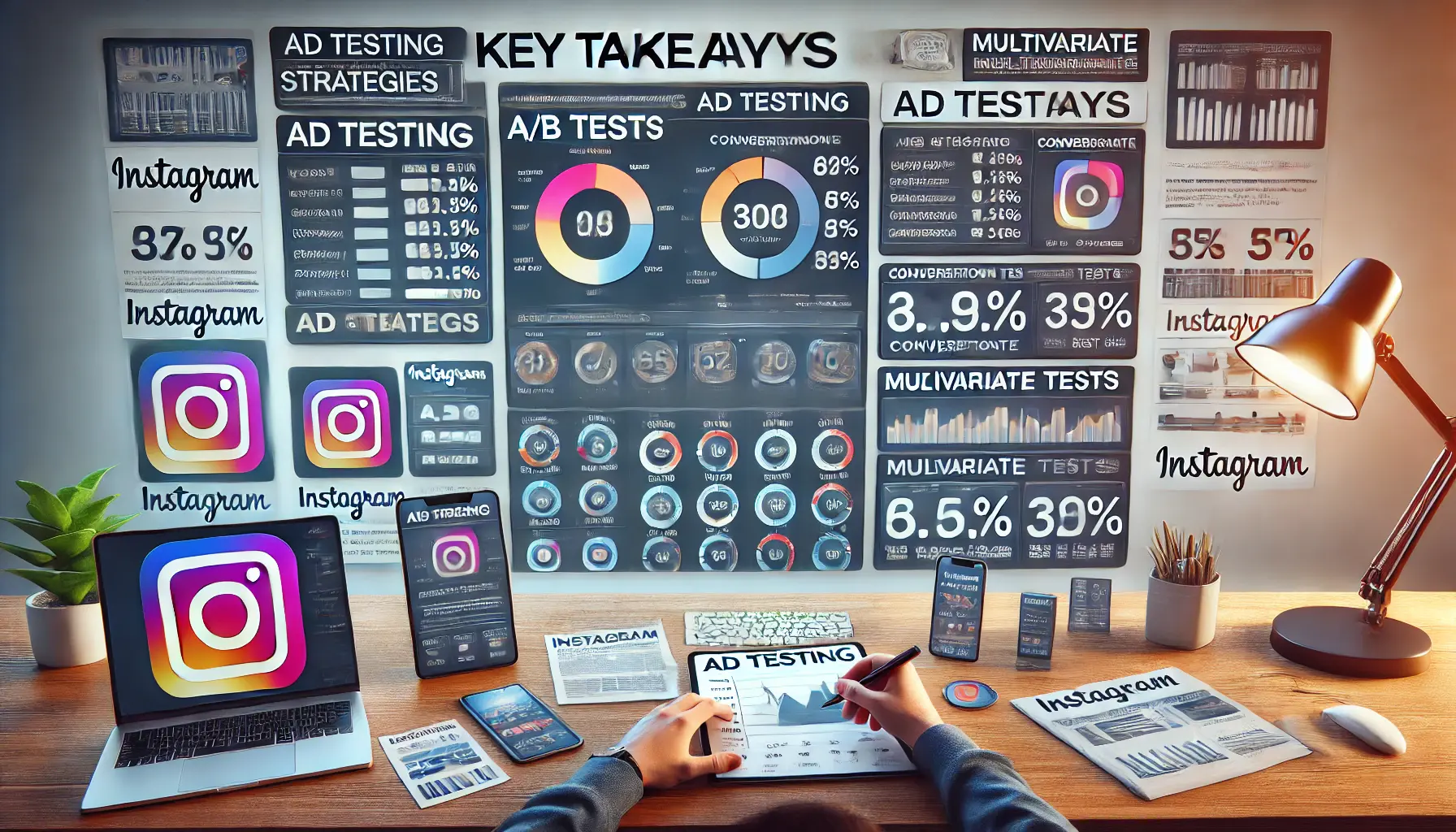
Illustration of key takeaways from ad testing strategies for Instagram campaigns, focusing on the insights gained from analyzing ad performance metrics.
Key Takeaways from Ad Testing Strategies
Throughout this article, we’ve covered key aspects of ad testing on Instagram, from understanding its importance to implementing effective testing strategies.
Here are the most important takeaways:
- Test One Thing at a Time: By isolating variables, you can identify what directly impacts ad performance.
- Use Multiple Types of Testing: A/B testing, multivariate testing, and sequential testing all offer unique insights into ad effectiveness.
- Monitor Key Metrics: CTR, CPC, engagement rate, and ROAS provide actionable data for optimizing ads.
- Leverage Instagram’s Tools: Utilizing Instagram’s native analytics and A/B testing features simplifies and enhances the testing process.
- Optimize and Evolve Continuously: The digital advertising landscape is always changing—staying ahead requires ongoing testing and adaptation.

Illustration of the final thoughts phase in an Instagram ad testing process, where a marketer reviews key insights and makes final adjustments.
Final Thoughts
Ad testing is an ongoing process that requires strategic planning, in-depth analysis, and continuous optimization.
Instagram is a dynamic platform, and what works today may not be effective tomorrow.
By applying the best practices discussed, advertisers can stay ahead of the competition and ensure their campaigns remain relevant and influential.
For marketers and businesses, investing time in testing advertisements is not optional—it’s essential for long-term success and sustainable growth.
Start testing today, monitor your outcomes, and refine your strategy to maximize your Instagram advertising potential.
Ad testing isn’t a one-time task; it requires continuous experimentation to keep up with changes in audience behavior and platform algorithms.
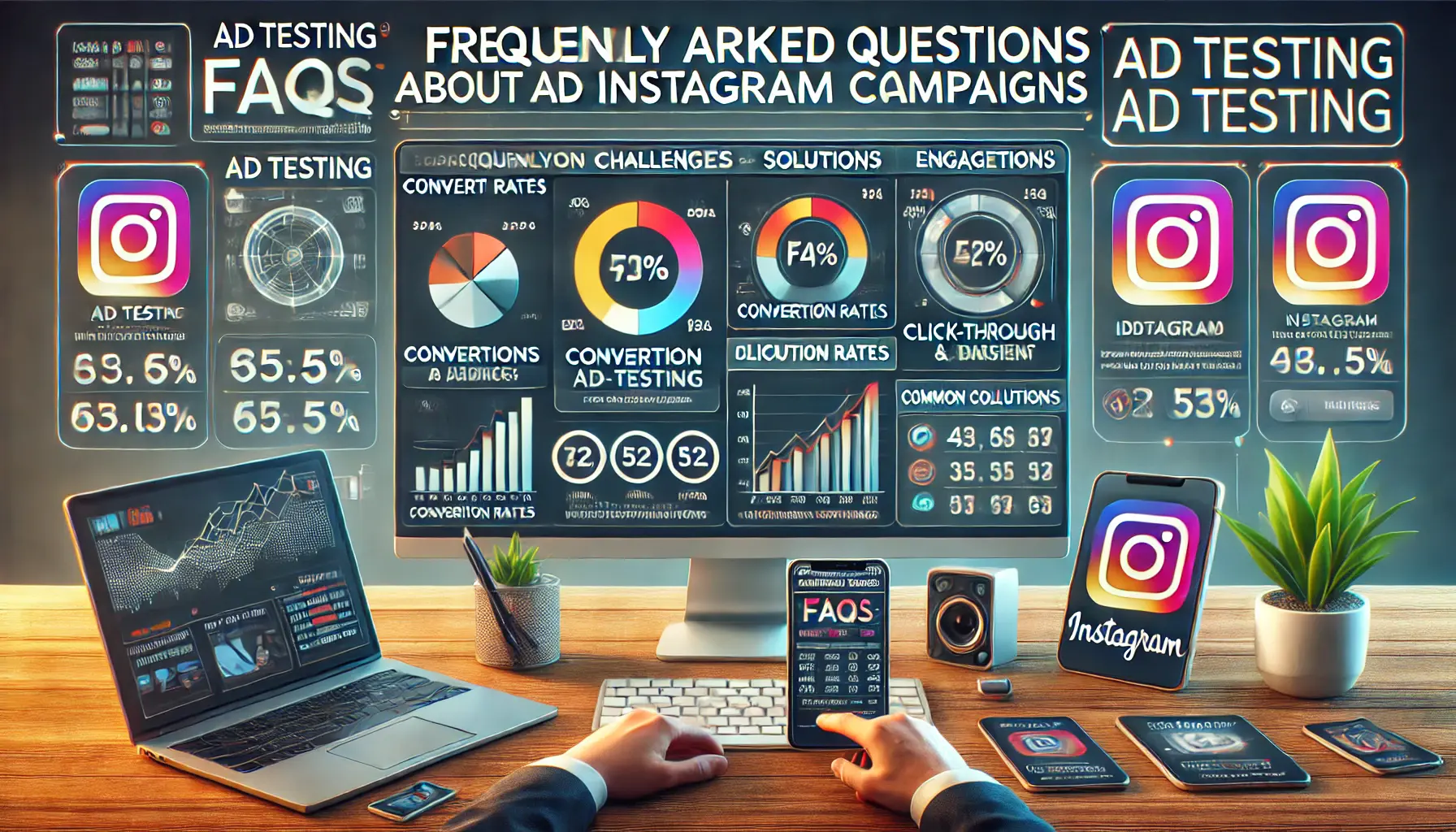
Illustration of a marketer analyzing Instagram ad testing metrics, suitable for a Q&A session about common challenges and solutions in ad testing.
Enjoyed the article? Let its author handle your social media ads. Visit our service page to get started!
Frequently Asked Questions About Ad Testing in Instagram Campaigns
Ad testing is a crucial component of optimizing your Instagram marketing efforts.
Below are some common questions and concise answers to help you understand its significance and implementation.
Ad testing, or A/B testing, involves comparing different ad versions to determine which performs better, enhancing engagement and conversions.
Ad testing identifies effective strategies, optimizes budget allocation, and improves ROI by focusing on high-performing ad elements.
Test variables like images, videos, headlines, ad copy, call-to-action buttons, and ad formats to identify what resonates best with your audience.
Create two ad versions differing in one element, run them simultaneously, and analyze performance metrics to determine the more effective option.
Run ad testing for at least 7 days to gather sufficient data, avoiding periods with significant external events that could skew results.
Key metrics include click-through rate (CTR), conversion rateThe percentage of users who complete a desired action, such as making a purchase, after clicking an ad., cost per click (CPC), engagement rate, and return on ad spend (ROAS).
Yes, multivariate ad testing allows simultaneous testing of multiple elements, but it requires a larger sample size for accurate results.
Use a sufficiently large sample size and run tests over an appropriate duration to achieve statistically significant results.
Implement insights by optimizing underperforming ads, scaling successful ones, and refining targeting based on demographicStatistical data about a population, such as age, gender, and location, used for targeted advertising. data.
